A brief history of diabetes tech innovations
7 min read


Diabetes management technology has come a long way since 1908—from helping clinicians manage and treat diabetes to helping people with diabetes manage their condition on their own.1
In the 21st century, diabetes management innovation happens frequently.1 With so many new tech options becoming available, it’s important for health care professionals to stay up to date; they play a key role in helping patients understand and adopt diabetes tech.2
Take a look at the timeline below to explore advancements in 2 main areas of diabetes management: insulin delivery and monitoring. And in some cases, tech that can do both.
1908
Monitoring
Glucose testing with copper reagent
The test that replaced urine tasting in diabetes diagnosis; it let clinicians test glucose levels by heating a copper solution with the patient’s urine3,4

1923
Insulin delivery
Production of insulin
Commercial production of the first laboratory-made insulin; heavy, reusable syringes for insulin administration started being made in 19243,5
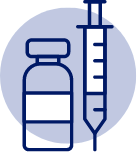
1954
Insulin delivery
Disposable glass syringes
Invention of the first disposable glass syringes; led to the development of disposable plastic syringes, which reduced pain and incidence of needle-associated infections in patients5

1963
Monitoring
Dextrostix
A paper strip that changed color in proportion to the amount of glucose in a drop of blood6

1970
Monitoring
First blood glucose meter and glucose self-monitoring system
The first version of the Ames Reflectance Meter (ARM) could read reflected light from a Dextrostix; it was heavy, expensive, and was intended for clinician office use6
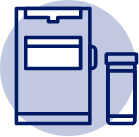
1976
Insulin delivery
The “blue brick” insulin pump
The first wearable insulin pump, also known as the “autosyringe”; it helped lead to the introduction of the first commercial insulin pump in 19795
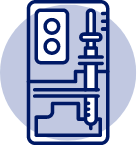
1980
Monitoring
Home blood glucose meter
The Dextrometer, a glucose meter with a digital display that allowed patients to check glucose at home; over the next decade, patient self-monitoring of blood glucose (SMBG) became the standard of care, especially for people living with type 1 diabetes4
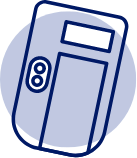
1985
Insulin delivery
First insulin pen
This had the 3 components of all insulin pens: an insulin cartridge, a disposable needle, and incremental dosing with 1-click per unit; first-generation insulin pens would be on the market commercially in the 1990s and facilitate patients giving themselves insulin injections5

1999
Monitoring
First continuous glucose monitor (CGM)
The first device that could continuously monitor glucose levels through an implantable sensor on the skin; patients could wear it for 3 days but could not see the glucose data, which would be downloaded to their clinician after they wore it; real-time CGM would get to market in 20057
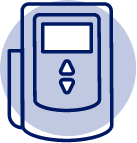
2006
Combined delivery + monitoring
First integrated insulin pump and CGM system
The first commercially marketed sensor-augmented insulin pump; the CGM sensor data helped adjust the basal rate and moved insulin delivery closer to a “closed-loop” system5
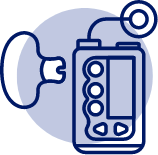
2011
Insulin delivery
Insulin “patch” pump
The first tubeless insulin delivery device that adheres to the skin without an additional infusion set5

2013
Combined delivery + monitoring
“Artificial pancreas” and hybrid closed-loop systems
While not a true pancreas substitute, this type of automated insulin delivery (AID) system uses a CGM, a control algorithm, and an infusion pump to help regulate insulin delivery; early versions that could suspend insulin delivery were FDA-approved as early as 2013; the first hybrid closed-loop system that could control the basal rate to keep glucose levels within precise targets was approved in 20175
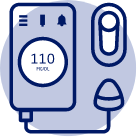
2015
Monitoring
Mobile app integration
The first mobile apps that could display glucose data from CGMs arrived in 2015; today many apps integrate with CGMs, and some may help with carb counting, calculating bolus insulin doses, social support, and more5,7,8

2017
Combined delivery + monitoring
Connected insulin pens
These “smart” insulin pens (or pen caps) have a digital memory and wireless connectivity; they record insulin dose data and can send it to a smartphone via near-field communication technology5
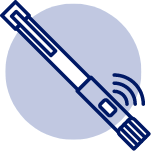
2019
Combined delivery + monitoring
Alternate controller enabled (ACE) infusion pumps
These insulin pumps are designed to be interoperable with technologies such as AID systems, CGMs, BGMs, and other electronics; this allows people living with diabetes to individualize how they use these technologies5,9

2024
Monitoring
Over-the-counter CGM
The FDA approved the first nonprescription CGM for patient use10


With diabetes technology evolving at a rapid pace, people living with diabetes may rely on their health care teams to help them understand their options.
Keep up with existing and emerging diabetes tech to help your patients navigate the digital health landscape.
Diabetes Tech-upTM is sponsored by Novo Nordisk. Learn more about Novo Nordisk’s heritage of innovations in health technology.
–— Recommended for you –—
References
- Zahid M, Dowlatshahi S, Kansara AH, Sadhu AR. The evolution of diabetes technology – options toward personalized care. Endocr Pract. 2023;29(8):653-662. doi:10.1016/j.eprac.2023.04.007
- Patil SP, Albanese-O’Neill A, Yehl K, Seley JJ, Hughes AS. Professional competencies for diabetes technology use in the care setting. Sci Diabetes Self Manag Care. 2022;48(5):437-445. doi:10.1177/26350106221120889
- Vecchio I, Tornali C, Bragazzi NL, Martini M. The discovery of insulin: an important milestone in the history of medicine. Front Endocrinol. 2018;9:613. doi:10.3389/fendo.2018.00613
- Hirsch IB, Battelino T, Peters AL, Chamberlain JJ, Aleppo G, Bergenstal RM. Role of Continuous Glucose Monitoring in Diabetes Treatment. American Diabetes Association. 2018. Accessed February 2024. https://www.ncbi.nlm.nih.gov/books/NBK538971
- Kesavadev J, Saboo B, Krishna MB, Krishnan G. Evolution of insulin delivery devices: from syringes, pens, and pumps to DIY artificial pancreas. Diabetes Ther. 2020;11(6):1251-1269. doi:10.1007/s13300-020-00831-z
- Tonyushkina K, Nichols JH. Glucose meters: a review of technical challenges to obtaining accurate results. J Diabetes Sci Technol. 2009;3(4):971-980. doi:10.1177/193229680900300446
- Didyuk O, Econom N, Guardia A, Livingston K, Klueh U. Continuous glucose monitoring devices: past, present, and future focus on the history and evolution of technological innovation. J Diabetes Sci Technol. 2021;15(3):676-683. doi:10.1177/1932296819899394
- Fu HNC, Wyman JF, Peden-McAlpine CJ, Draucker CB, Schleyer T, Adam TJ. App design features important for diabetes self-management as determined by the self-determination theory on motivation: content analysis of survey responses from adults requiring insulin therapy. JMIR Diabetes. 2023;24(8):e38592. doi:10.2196/38592
- FDA authorizes first interoperable insulin pump intended to allow patients to customize treatment through their individual diabetes management devices. US Food and Drug Administration. February 14, 2019. Accessed May 2024. https://www.fda.gov/news-events/press-announcements/fda-authorizes-first-interoperable-insulin-pump-intended-allow-patients-customize-treatment-through
- FDA clears first over-the-counter continuous glucose monitor. US Food and Drug Administration. March 5, 2024. Accessed March 2024. https://www.fda.gov/news-events/press-announcements/fda-clears-first-over-counter-continuous-glucose-monitor
The Diabetes Tech-upTM Podcast
Join our expert cohosts for a series of discussions about how they’re integrating diabetes tech with patient-centered care to help optimize diabetes management.
The Mission of Diabetes Tech-upTM
Diabetes Tech-upTM is sponsored by Novo Nordisk, a global leader in diabetes. We believe that adoption of innovative technologies can help appropriate patients better manage diabetes. Our goal is to provide information to help health care professionals on the front line of diabetes care strengthen their understanding of diabetes technologies and implement them where they can have the greatest impact.



